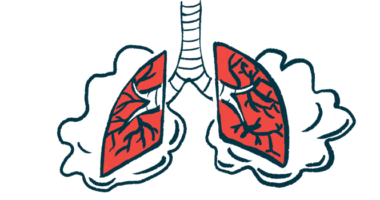Triple-combo CFTR modulator leads to lung function, life quality gains
Benefits seen across range of patients with real-world use of Kaftrio in Germany

A year of treatment with Kaftrio (elexacaftor/tezacaftor/ivacaftor) led to gains in lung function and nutritional status for cystic fibrosis (CF) patients in Germany, a real-world study in over 2,600 people reported.
Sold as Trikafta in the U.S. and Canada, Kaftrio’s use also resulted in fewer in pulmonary exacerbations and lower sweat chloride levels.
“These findings provide important insights into the real-world impact of [Kaftrio] on [people with CF] in Germany,” the scientists wrote, noting that benefits were observed across patients of varying ages and clinical characteristics, and were consistent with those reported in clinical trials.
“Current CFTR modulator therapies, such as elexacaftor–tezacaftor–ivacaftor, have transformed cystic fibrosis care,” they wrote.
The study, “Impact of elexacaftor/tezacaftor/ivacaftor on lung function, nutritional status, pulmonary exacerbation frequency and sweat chloride in people with cystic fibrosis: real-world evidence from the German CF Registry,” was published in The Lancet Regional Health – Europe.
CFTR modulator given in clinic to 2,645 adult and adolescent patients
Vertex Pharmaceuticals’ Kaftrio is a triple-combination CFTR modulator approved in more than 30 countries for patients with eligible mutations in the CFTR gene, including F508del, the most common CF-causing mutation. It works to boost the function of the CFTR protein that’s defective in the disease.
Clinical trial and real-world data associate a range of benefits with Kaftrio/Trikafta, including improved lung function, nutritional status, and life quality, as well as fewer pulmonary exacerbations (acute bouts of worsening lung symptoms).
The triple combination also lowers sweat chloride concentrations, a widely used clinical marker of CFTR function, where reductions indicate a better working protein.
Scientists analyzed outcomes with Kaftrio treatment in CF patients, ages 12 and older, in Germany, where the therapy is currently approved for those with at least one copy of the F508del mutation.
Their analysis included 2,645 patients, with a mean age of 28, who were enrolled in the German CF registry and followed for at least one year after starting the triple combo therapy.
Lung function was assessed by forced expiratory volume in one second, an evaluation of how much air a person can forcibly exhale in a single breath. It’s expressed as a percentage of what is expected based on a person’s age and sex (ppFEV1).
A significant and consistent improvement in lung function with Kaftrio was noted compared with the group’s starting, or baseline, lung function. Over a year of treatment, patients’ ppFEV1 values significantly increased by an average of 11.3%.
Lung function gains were greater among people not previously given any CFTR modulator than among those who had used at least of these therapies.
Specifically, ppFEV1 values increased by 12.6% in naïve patients and by 9.7% in those on a prior modulator.
Improving lung health evident in patients with advanced lung disease
The proportion of patients with a more than 80% rise in ppFEV1 increased from 29.8% before Kaftrio to 48.2% during treatment.
A decrease in patients with advanced lung disease also was observed, consistent with previous clinical trial data indicating that Kaftrio “has a positive effect not only in individuals with mild-to-moderate CF but also in those with advanced pulmonary disease,” the scientists wrote.
“Fewer individuals had a ppFEV1 of ≤40% after treatment” with Kaftrio, the study stated. For patients with advanced lung disease and a ppFEV1 of 40% or less, “experiencing an improvement in their condition and transitioning to the next ppFEV1 range of 40–60% is a significant outcome.”
Body mass index (BMI), an indicator of nutritional status, improved significantly with treatment among adults, and the proportion of underweight patients fell while the proportion of overweight or obese patients rose. Findings were similar among the study’s 614 adolescents.
Before starting Kaftrio, 30% of the patients were using high-calorie supplemental feeding. After a year of treatment, 24.2% continued with such supplements.
“Nutrition issues should remain a focus of management for individuals with CF, even after reaching a healthy weight,” the researchers wrote, noting that this is especially important given the risk of obesity-related cardiovascular disease.
Fewer exacerbations, lower sweat chloride levels with year of treatment
Pulmonary exacerbations decreased by a significant 75.9%, from 2,262 total exacerbations in the year before Kaftrio to 546 in the year after.
The researchers noted that isolation and mask-wearing due to the COVID-19 pandemic may have contributed to this reduction, but “there is no doubt that treatment with [Kaftrio] reduces the number of pulmonary exacerbations.”
Mean sweat chloride concentrations also significantly decreased, falling from 97 millimoles per liter (mmol/L) in the year prior to starting Kaftrio to 46.1 mmol/L in the year after starting it. Significantly greater reductions were seen in female than in male patients.
“The findings of this real-world study showed statistically significant improvements in clinical outcomes 12 months after initiation,” the researchers concluded.
Side effects related to treatment were not documented in the German CF Registry, marking a study limitation, “especially in the context of growing concerns regarding intolerance of CFTR modulator therapy,” they added.








